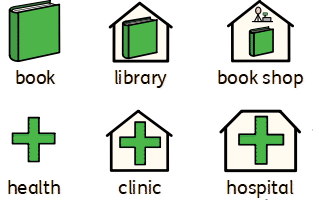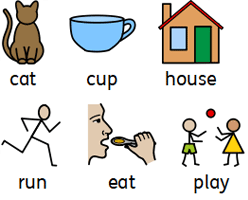- You are here:
- Home
- About Symbols
- Guide to good symbol content
- Widgit Symbol Structure
Guide to good symbol content
Widgit Symbol Structure
Schematic structure

The Widgit Symbols follow a schematic structure, meaning that there are ‘rules’ for the way in which they are formed. These ‘rules’ for symbol composition quickly become recognisable to new users, giving a level of independence in learning the conventions within the symbols.
A good example of this structure is the set of conventions followed by the symbols for buildings. A symbol that represents a building will feature a standard outline of a building, which contains another symbol that gives information about the type of building it is. The scale of the building is indicated by the shape of the roof: a flat roof represents a large building, such as a hospital, and a pointed roof represents a smaller building, such as a clinic.
The inclusion of other elements within a ‘building’ symbol can change the nature of the symbol again. For example, adding a cash register to the ‘book in a building’ symbol would indicate a bookshop rather than a library. Once these rules have been learned, it is easy to recognise the concept being depicted by the symbol, even when the symbol features three or more elements.
Levels of Symbols
There are three levels of complexity within the Widgit Symbol Set: Transparent, Learned and Abstract.
Transparent

‘Transparent’ symbols are very obvious depictions of the concepts that they illustrate. The reader does not need to rely upon the symbol’s context (i.e. to understand any of the words in the sentence, or pay attention to the other symbols) to be able to understand what the symbol means. As long as the reader is familiar with the concept that is being illustrated, they should be able to interpret the symbol.
Learned

The second level of symbol, ‘learned’, is more conceptual and therefore needs to be learned. The consistent nature of ‘learned’ symbols means that the concepts they represent become obvious when they are shown together.
In this example, the concepts of the words are illustrated by the varying relationship between the red ball and the box. If the ‘in’ symbol was seen without the word or the other symbols to provide context, it could be difficult to understand. However, having seen the symbols for related concepts, the reader is able to make an educated guess at the meaning, even without being able to understand the words.
Abstract

At the third and highest level are the ‘abstract’ symbols. Abstracts are symbols that have no obvious meaning when viewed on their own, and typically represent determiners (e.g. a, an, the) or adpositions (e.g. of, to, with). While their meaning can often be inferred by the context in which they are used, abstracts may actually be a distraction to some readers.
In fact, not using abstract symbols to symbolise, for example, a determiner in a sentence, can actually help the meaning of the sentence to become more obvious.
Generally, it is recommended that you do not use abstract symbols unless they are requested, or they fall into one of the following two circumstances:
- If you are writing for a symbol reader who is learning the first 45 words*, then you would have the abstract symbols accompany words such as ‘the’ to enable the reader to identify the word.
- In some schools, where students have more profound needs, every word may be symbolised so that the students know that they are not missing any of the meaning in the text.
*The National Literacy Strategy includes a list of 45 words to be taught by the end of Reception (age five).
Qualifiers
Qualifiers are grammatical markers that appear as part of the symbol when you are using a word that is superlative or comparative, past or future tense, or plural.
Comparatives and superlatives

This example shows the comparative and superlative of the word ‘big’.
Comparatives are always denoted by a single grey exclamation mark next to the symbol; two grey exclamation marks indicate a superlative.
Tense markers

Past tense markers are arrows that sit above the symbol and literally ‘point’ to the past.
They are used to indicate that the concept being illustrated happened in the past, rather than the present. Forward tense markers are also used in some languages; for example, the English word ‘will’.
Plurals

Pluralised concepts are represented by a ‘double plus’ qualifier being included in the symbol next to the main graphic. The ‘double plus’ indicates that there are multiples of the concept that is being illustrated.
Guide home | Next - Choosing how to symbolise your content
